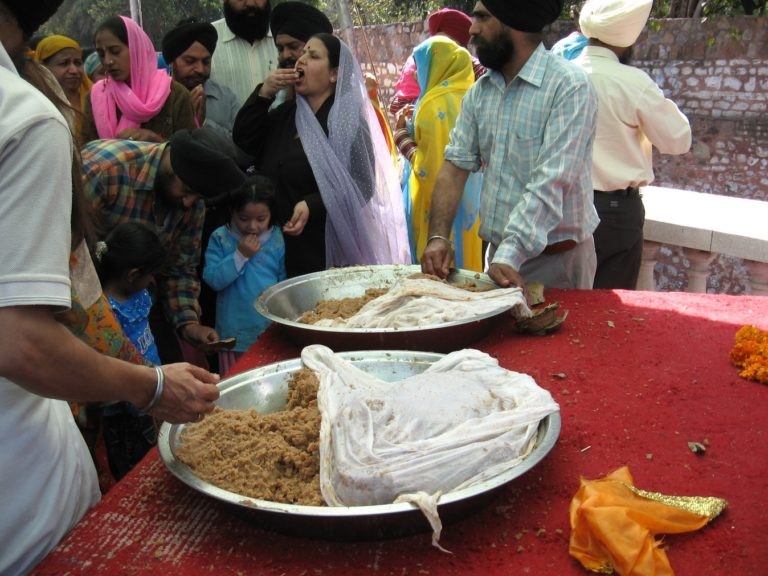Karah Prashad, a type of religious pudding similar to sweet, is regarded as a delicacy and is prepared in a specific manner. After any religious ceremony, it is served to the sangat. While reciting verses, Prashad is created from equal amounts of wheat flour, ghee, and sugar. Prashad is cooked in the langar kitchens of a gurdwara. The offering of Ardas, a prayer, is typically done before reciting a hukam from the Guru Granth Sahib to bless Prashad.
Prashad is draped on a clean cloth and put at the front of the Guru Granth Sahib on a modest, tidy pedestal. In the existence of the Guru Granth Sahib and the assemblage, the first five and concluding stanzas of the text Anand Sahib are chanted or recited loudly.
A Sikh unsheathes a kirpan, a ritual small sword. The Sikh faces Siri Guru Granth Sahib and carries the kirpan handle among the folded hands. At the right period of Ardas, immediately prior to its completion, the Sikh contacts the kirpan to the Prashad, sliding the steel through it.
Five shares of Prashad are withdrawn from the main bowl and served, one for each of the five cherished panj pyara. One portion is removed and placed in a tiny dish for each Sikh who attends Siri Guru Granth Sahib. The remaining Prashad is handed to the Sangat, or community, regardless of prejudice to socioeconomic status, caste, color, or creedThe history behind Parshad:
Once Guru Nanak Dev Ji met the Sidhs, he prepared the first Kadah Prashad. While conversing with Guru Ji, the Sides expressed their hunger and explained that they couldn’t eat anything solid or hard because they were elderly and lacked teeth (to test Guru Ji). Guru Ji then instructed Bhai Mardana to procure wheat, ghee, and sugar (khand), and to cook the nectar in the manner of Kadah Prashad, which the Sadhus could readily consume. Since then, Kadah Prashad has been presented after all diwans and during the times of all Guru Sahibs.
Guru Ji combined equal parts sugar (sweet) and flour (bland) and suggested distributing after every ceremony, as the Gurbani ideology encourages us to always find the right balance between pleasure and sorrow.
We provide Karah Parshad when a child is born. We continue to serve Karah Parshad even if someone goes away. A gentle reminder that contentment and misfortune go synonymously in life. Don’t get so caught up in happiness that you lose your equilibrium when melancholy strikes, and conversely. Karha Parshad is basically from God to everyone that should be accepted with humility and devotion towards God. You can also prepare the same at home just for taste purposes.
Significance Of Karha Parshad
It represents the Guru’s wealth and nourishment, as well as the fact that it all we obtain in life is the Guru’s favor (Prashad) and hence delicious. Everybody gets the same amount, demonstrating that everybody is equivalent in Waheguru’s eyes.
Giving karah parshad ensures that no one departs the Guru’s presence (Gurdwara) without receiving something. Even though both Karah Prashad and Langar have a long history, the practice of parshad differs significantly from the tradition of langar.
Karah Prashad is partly confined to Sikhs since its acceptance implies a promise to follow the Guru’s Hukam (command), while langar, by itself, has no such implication langar is open to everybody. Although some have recently begun to put the kirpan to a dish of langar, this is a new trend that does not correspond to the Karah parshaad custom.








